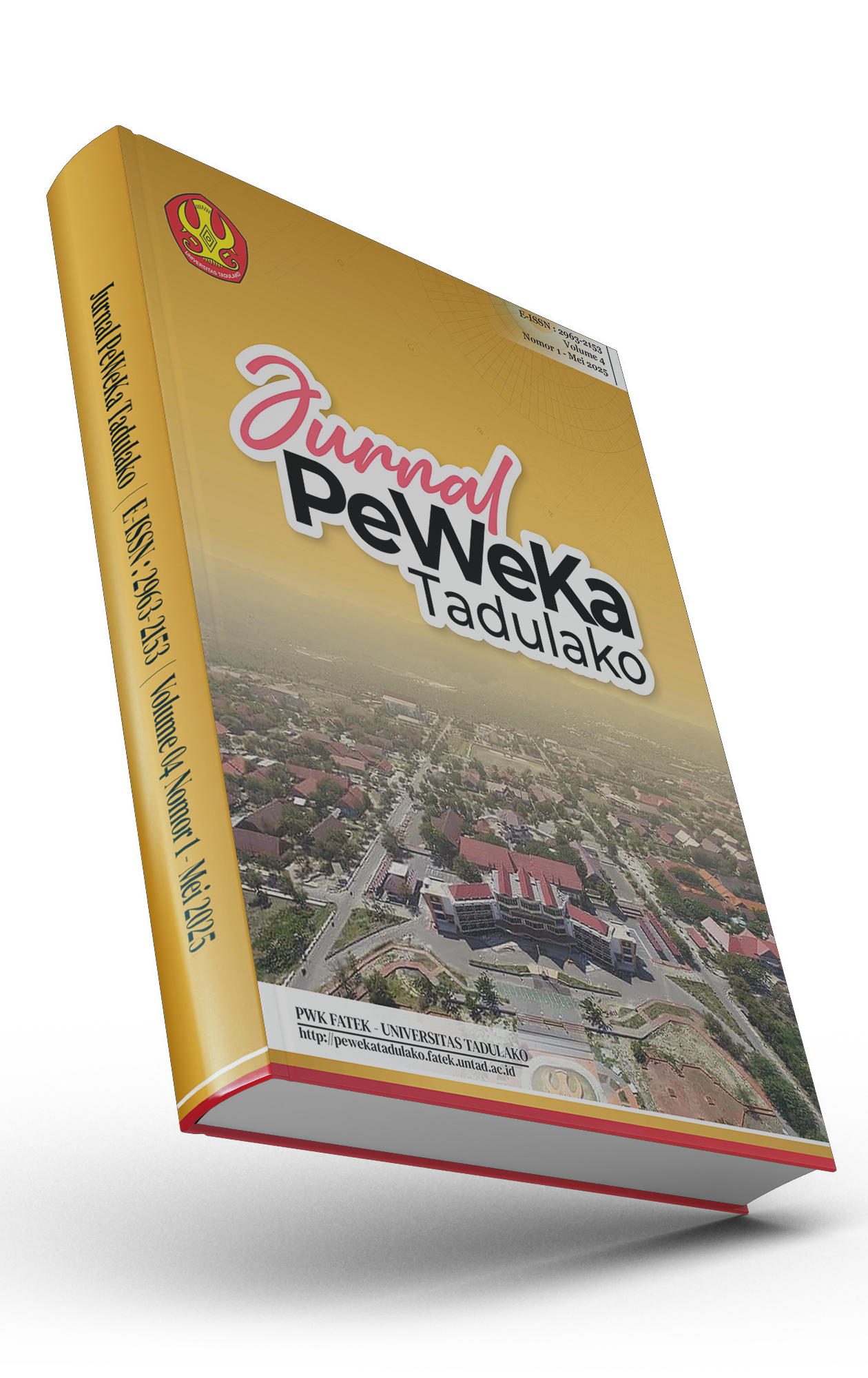Analisis Tingkat Risiko Banjir pada Daerah Aliran Sungai (DAS) Bialo Provinsi Sulawesi Selatan
DOI:
https://doi.org/10.22487/peweka.v4i1.46Keywords:
Hazard, Vulnerabilty, Capacity, RiskAbstract
Watershed (DAS) can simply be interpreted as one of the containers that has the function of flowing rainwater into the lake or sea. Land use change in the upper reaches of the Bialo watershed which causes cultivation are one of the causes of flooding in the downstream area of the Bialo watershed. The purpose of this study is to analyze the level of hazard, vulnerability, capacity, and risk of flooding in the Bialo River Basin. The data collection method in this study used interviews, documentation, observation, and literature studies. The analytical methods used in this study are quantitative descriptive methods, spatial analysis, and qualitative descriptive. Quantitative descriptive methods are used to analyze hazard, vulnerability, capacity and risk. Spatial analysis that used in the process of modeling the results of calculating the hazard, vulnerability, capacity, and risks. Qualitative descriptive methods are used to interpret the results of spatial analysis. The results of this study is shows that the level of flood risk in the Bialo watershed consisted of 3 classifications, namely low, medium and high. Low Area 3342.39 Ha, Medium 6748.27 Ha and High 807.86 Ha.
References
Aisha, M., Miladan, N., & Utomo, R. P. (2019). Kajian Kerentanan Bencana pada Kawasan Berisiko Banjir DAS Pepe Hilir, Surakarta. Region: Jurnal Pembangunan Wilayah Dan Perencanaan Partisipatif, 14(2), 205-219.
Asman, A. I., Sakti, H. H., Aras, D., Wahyuni, N., & Aldiansyah, F. (2023). Flood Disaster Risk Reduction Strategies in Urban Area, Bulukumba Regency. PENA TEKNIK: Jurnal Ilmiah Ilmu-Ilmu Teknik, 8(1), 149–160. https://doi.org/10.51557/PT_JIIT.V8I1.1645
Asnidar, S., & Zuraidah, S. (2022). Analisis Dependency Ratio dan Sex Ratio terhadap Pertumbuhan Ekonomi Kota Langsa. Indonesian Journal of Business Analytics, 2(2), 129-138.
Azizah, M. A., Subiyanto, A., Triutomo, S., & Wahyuni, D. (2022). Pengaruh perubahan iklim terhadap bencana hidrometeorologi di kecamatan cisarua-kabupaten bogor. PENDIPA Journal of Science Education, 6(2), 541-546.
Badan Nasional Penanggulangan Bencana. (2012). Peraturan Kepala Badan Nasional Penanggulangan Bencana Nomor 2 Tahun 2012 tentang Pedoman Umum Pengkajian Risiko Bencana.
Badan Nasional Penanggulangan Bencana. (2016). Risiko Bencana Indonesia. Jakarta: Badan Nasional Penanggulangan Bencana (BNPB).
Eato, S. D. K. H., Rengkung, M. M., & Van Rate, J. (2017). Strategi Penanganan Banjir Berbasis Mitigasi Bencana Pada Kawasan Rawan Bencana Banjir Di Kecamatan Bolangitang Barat Kabupaten Bolaang Mongondow Utara. Spasial, 4(3), 108-120.
Harsiwi, R. S., & Setyono, J. S. (2015). Tingkat kerentanan ekonomi wilayah kabupaten wonigiri. Teknik PWK (Perencanaan Wilayah Kota), 4(4), 578-591.
Hermon, D. (2012). Mitigasi Bencana Hidrometeorlogi: Banjir, Longsor, Degradasi Lahan, Ekologi, Kekeringan, dan Puting Beliung. UNP Press.
Republik Indonesia. (2007). Undang-undang No. 24 tahun 2007 tentang Penanggulangan Bencana.
Latief, R., Barkey, R. A., & Suhaeb, M. I. (2021). Perubahan Penggunaan Lahan Terhadap Banjir di Kawasan Daerah Aliran Sungai Maros. Urban and Regional Studies Journal, 3(2), 52–59. https://doi.org/10.35965/URSJ.V3I2.669
Melianita, R., Putra, A. D., & Syah, A. (2021). Analisis Potensi Kerentanan dan Risiko Bencana di Wilayah Kabupaten Tanggamus. Jurnal Rekayasa Sipil dan Desain, 9(3), 437-448.
Novaliadi, D., & Hadi, M. P. (2014). Pemetaan Kerawanan Banjir dengan Aplikasi Sistem Informasi Geografis di Sub DAS Karang Mumus Provinsi Kalimantan Timur. Jurnal Bumi Indonesia, 3(4).
Nugraha, A., & Syusetyaningsih, A. (2021). Analisis Potensi Tanah Longsor di Jalan Raya Cikajang Pameungpeuk Daerah Batu Numpang. Jurnal Konstruksi, 19(2), 377-387.
Sulistyani, K. F., & Irianto, D. B. (2021). Kajian Risiko Bencana Banjir dan Tanah Longsor untuk Desa-Desa di DAS Sembakung, Nunukan Kalimantan Utara. PROSIDING SENTIKUIN, 6th SEMINAR NASIONAL TEKNOLOGI INDUSTRI, LINGKUNGAN DAN INFRASTRUKTUR: Vol. 4.
Downloads
Published
How to Cite
Issue
Section
License
Copyright (c) 2025 Farhan Aldiansyah, Despry Nur Annisa Ahmad, Andi Idham Asman

This work is licensed under a Creative Commons Attribution-ShareAlike 4.0 International License.







